2010 FORD F250 SUPER DUTY heating
[x] Cancel search: heatingPage 297 of 408
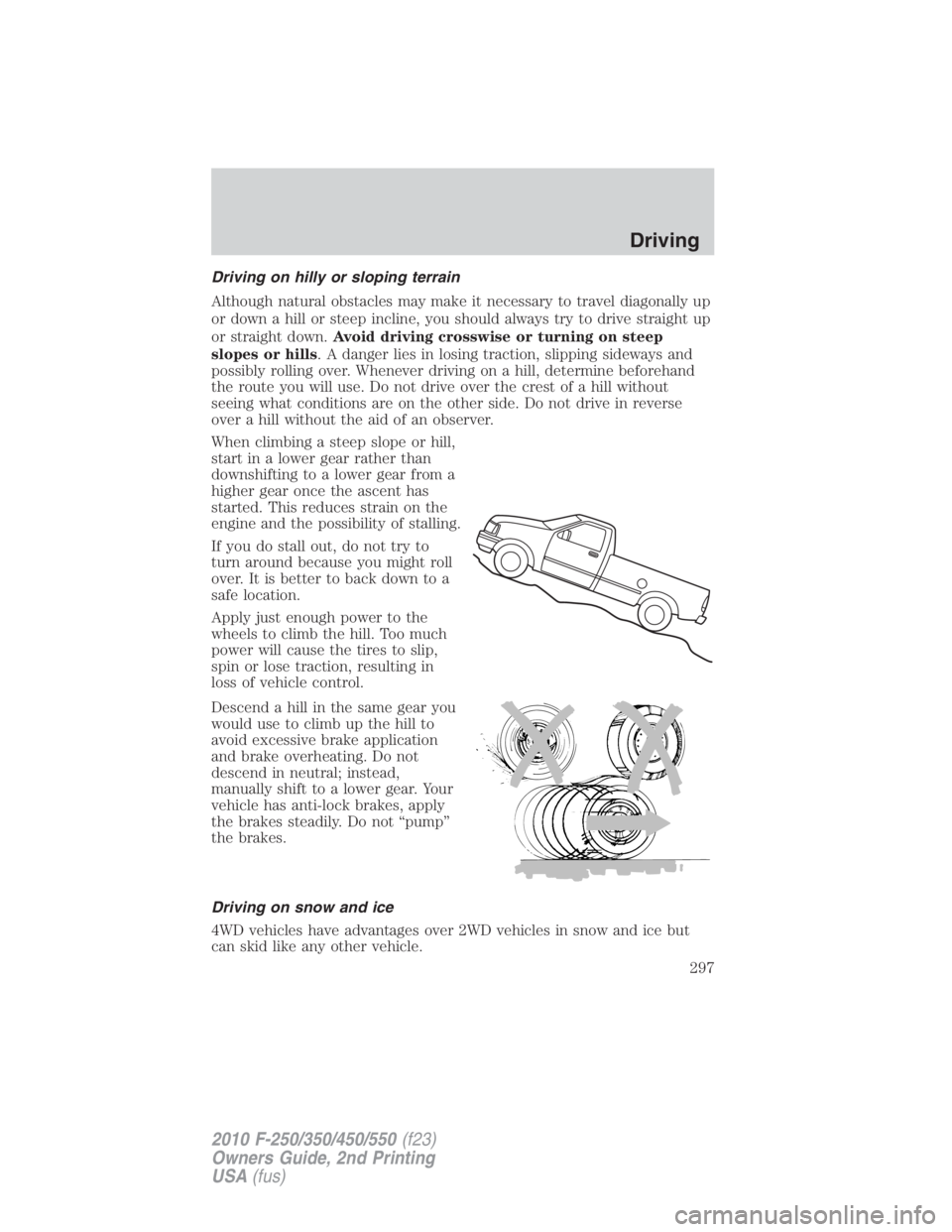
Driving on hilly or sloping terrain
Although natural obstacles may make it necessary to travel diagonally up
or down a hill or steep incline, you should always try to drive straight up
or straight down. Avoid driving crosswise or turning on steep
slopes or hills . A danger lies in losing traction, slipping sideways and
possibly rolling over. Whenever driving on a hill, determine beforehand
the route you will use. Do not drive over the crest of a hill without
seeing what conditions are on the other side. Do not drive in reverse
over a hill without the aid of an observer.
When climbing a steep slope or hill,
start in a lower gear rather than
downshifting to a lower gear from a
higher gear once the ascent has
started. This reduces strain on the
engine and the possibility of stalling.
If you do stall out, do not try to
turn around because you might roll
over. It is better to back down to a
safe location.
Apply just enough power to the
wheels to climb the hill. Too much
power will cause the tires to slip,
spin or lose traction, resulting in
loss of vehicle control.
Descend a hill in the same gear you
would use to climb up the hill to
avoid excessive brake application
and brake overheating. Do not
descend in neutral; instead,
manually shift to a lower gear. Your
vehicle has anti-lock brakes, apply
the brakes steadily. Do not “pump”
the brakes.
Driving on snow and ice
4WD vehicles have advantages over 2WD vehicles in snow and ice but
can skid like any other vehicle. Driving
297
2010 F-250/350/450/550 (f23)
Owners Guide, 2nd Printing
USA (fus)
Page 367 of 408
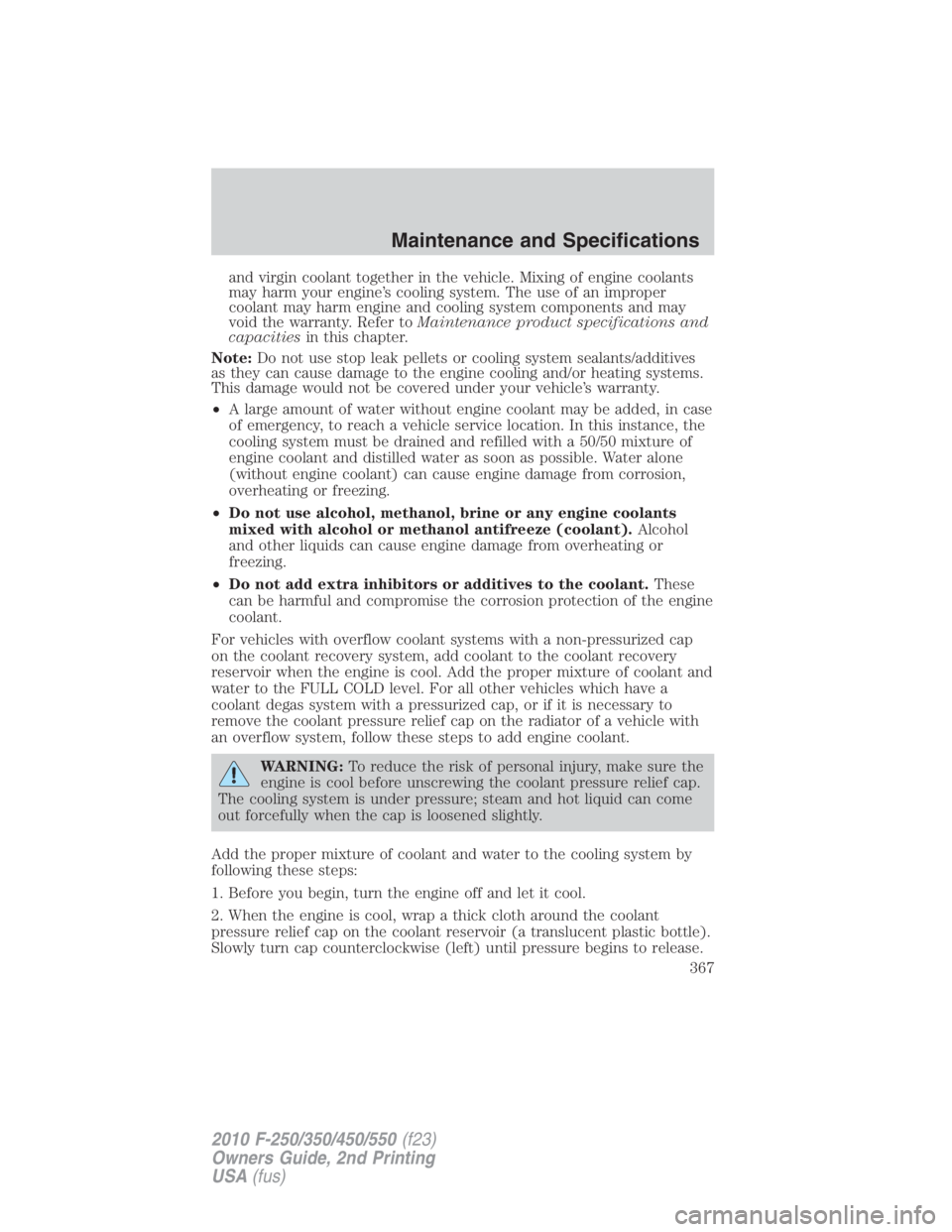
and virgin coolant together in the vehicle. Mixing of engine coolants
may harm your engine’s cooling system. The use of an improper
coolant may harm engine and cooling system components and may
void the warranty. Refer to Maintenance product specifications and
capacities in this chapter.
Note: Do not use stop leak pellets or cooling system sealants/additives
as they can cause damage to the engine cooling and/or heating systems.
This damage would not be covered under your vehicle’s warranty.
• A large amount of water without engine coolant may be added, in case
of emergency, to reach a vehicle service location. In this instance, the
cooling system must be drained and refilled with a 50/50 mixture of
engine coolant and distilled water as soon as possible. Water alone
(without engine coolant) can cause engine damage from corrosion,
overheating or freezing.
• Do not use alcohol, methanol, brine or any engine coolants
mixed with alcohol or methanol antifreeze (coolant). Alcohol
and other liquids can cause engine damage from overheating or
freezing.
• Do not add extra inhibitors or additives to the coolant. These
can be harmful and compromise the corrosion protection of the engine
coolant.
For vehicles with overflow coolant systems with a non-pressurized cap
on the coolant recovery system, add coolant to the coolant recovery
reservoir when the engine is cool. Add the proper mixture of coolant and
water to the FULL COLD level. For all other vehicles which have a
coolant degas system with a pressurized cap, or if it is necessary to
remove the coolant pressure relief cap on the radiator of a vehicle with
an overflow system, follow these steps to add engine coolant.
WARNING: To reduce the risk of personal injury, make sure the
engine is cool before unscrewing the coolant pressure relief cap.
The cooling system is under pressure; steam and hot liquid can come
out forcefully when the cap is loosened slightly.
Add the proper mixture of coolant and water to the cooling system by
following these steps:
1. Before you begin, turn the engine off and let it cool.
2. When the engine is cool, wrap a thick cloth around the coolant
pressure relief cap on the coolant reservoir (a translucent plastic bottle).
Slowly turn cap counterclockwise (left) until pressure begins to release. Maintenance and Specifications
367
2010 F-250/350/450/550 (f23)
Owners Guide, 2nd Printing
USA (fus)
Page 368 of 408

3. Step back while the pressure releases.
4. When you are sure that all the pressure has been released, use the
cloth to turn it counterclockwise and remove the cap.
5. Fill the coolant reservoir slowly with the proper coolant mixture, to
within the COLD FILL RANGE or the FULL COLD level on the reservoir.
If you removed the radiator cap in an overflow system, fill the radiator
until the coolant is visible and radiator is almost full.
6. Replace the cap. Turn until tightly installed. Cap must be tightly
installed to prevent coolant loss.
After any coolant has been added, check the coolant concentration (refer
to Checking engine coolant ). If the concentration is not 50/50
(protection to –34°F/–36°C), drain some coolant and adjust the
concentration. It may take several drains and additions to obtain a 50/50
coolant concentration.
Whenever coolant has been added, the coolant level in the coolant
reservoir should be checked the next few times you drive the vehicle. If
necessary, add enough 50/50 concentration of engine coolant and
distilled water to bring the liquid level to the proper level.
If you have to add more than 1.0 quart (1.0 liter) of engine coolant per
month, have your authorized dealer check the engine cooling system.
Your cooling system may have a leak. Operating an engine with a low
level of coolant can result in engine overheating and possible engine
damage.
Recycled engine coolant
Ford Motor Company does NOT recommend the use of recycled engine
coolant since a Ford-approved recycling process is not yet available.
Used engine coolant should be disposed of in an appropriate
manner. Follow your community’s regulations and standards for recycling
and disposing of automotive fluids.
Coolant refill capacity
To find out how much fluid your vehicle’s cooling system can hold, refer
to Maintenance product specifications and capacities in this chapter.
If your vehicle is equipped with a diesel engine, refer to the
Maintenance product specifications and capacities section of your 6.0
and 6.4 Liter Power Stroke Direct Injection Turbo Diesel Owner’s
Guide Supplement.Maintenance and Specifications
368
2010 F-250/350/450/550 (f23)
Owners Guide, 2nd Printing
USA (fus)
Page 370 of 408

How fail-safe cooling works
If the engine begins to overheat:
• The engine coolant temperature gauge will move to the red (hot)
area.
• The message center will indicate the engine is overheating.
• The service engine soon indicator will illuminate.
If the engine reaches a preset over-temperature condition, the engine
will automatically switch to alternating cylinder operation. Each disabled
cylinder acts as an air pump and cools the engine.
When this occurs the vehicle will still operate. However:
• The engine power will be limited.
• The air conditioning system will be disabled.
Continued operation will increase the engine temperature and the engine
will completely shut down, causing steering and braking effort to
increase.
Once the engine temperature cools, the engine can be re-started. Take
your vehicle to a service facility as soon as possible to minimize engine
damage.
When fail-safe mode is activated
You have limited engine power when in the fail-safe mode, so drive the
vehicle with caution. The vehicle will not be able to maintain high-speed
operation and the engine will run rough. Remember that the engine is
capable of completely shutting down automatically to prevent engine
damage; therefore:
1. Pull off the road as soon as safely possible and turn off the engine.
2. Arrange for the vehicle to be taken to a service facility.
3. If this is not possible, wait a short period for the engine to cool.
4. Check the coolant level and replenish if low.
WARNING: Never remove the coolant reservoir cap while the
engine is running or hot.
5. Re-start the engine and take your vehicle to a service facility.
Driving the vehicle without repairing the engine problem
increases the chance of engine damage. Take your vehicle to a
service facility as soon as possible.Maintenance and Specifications
370
2010 F-250/350/450/550 (f23)
Owners Guide, 2nd Printing
USA (fus)
Page 386 of 408
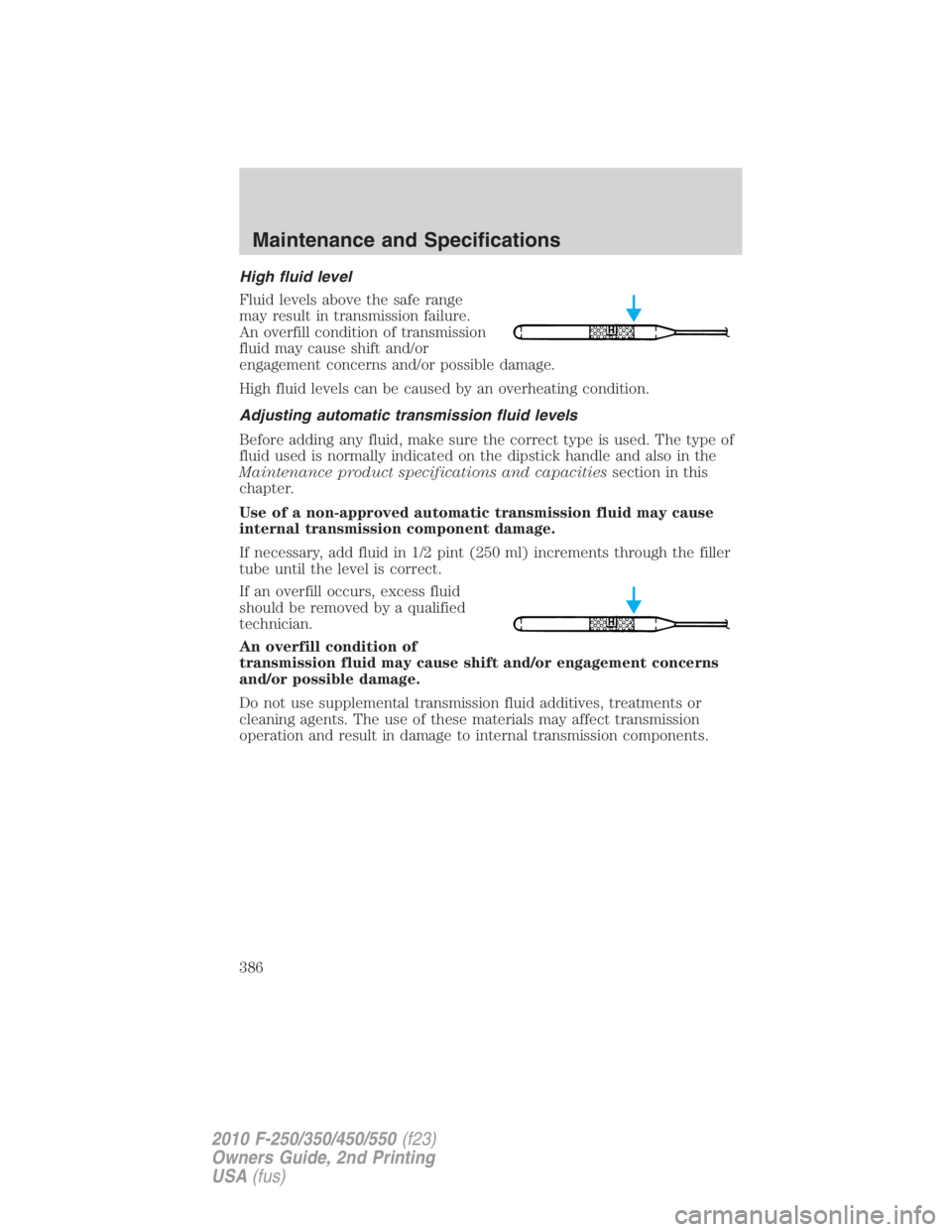
High fluid level
Fluid levels above the safe range
may result in transmission failure.
An overfill condition of transmission
fluid may cause shift and/or
engagement concerns and/or possible damage.
High fluid levels can be caused by an overheating condition.
Adjusting automatic transmission fluid levels
Before adding any fluid, make sure the correct type is used. The type of
fluid used is normally indicated on the dipstick handle and also in the
Maintenance product specifications and capacities section in this
chapter.
Use of a non-approved automatic transmission fluid may cause
internal transmission component damage.
If necessary, add fluid in 1/2 pint (250 ml) increments through the filler
tube until the level is correct.
If an overfill occurs, excess fluid
should be removed by a qualified
technician.
An overfill condition of
transmission fluid may cause shift and/or engagement concerns
and/or possible damage.
Do not use supplemental transmission fluid additives, treatments or
cleaning agents. The use of these materials may affect transmission
operation and result in damage to internal transmission components.Maintenance and Specifications
386
2010 F-250/350/450/550 (f23)
Owners Guide, 2nd Printing
USA (fus)
Page 404 of 408
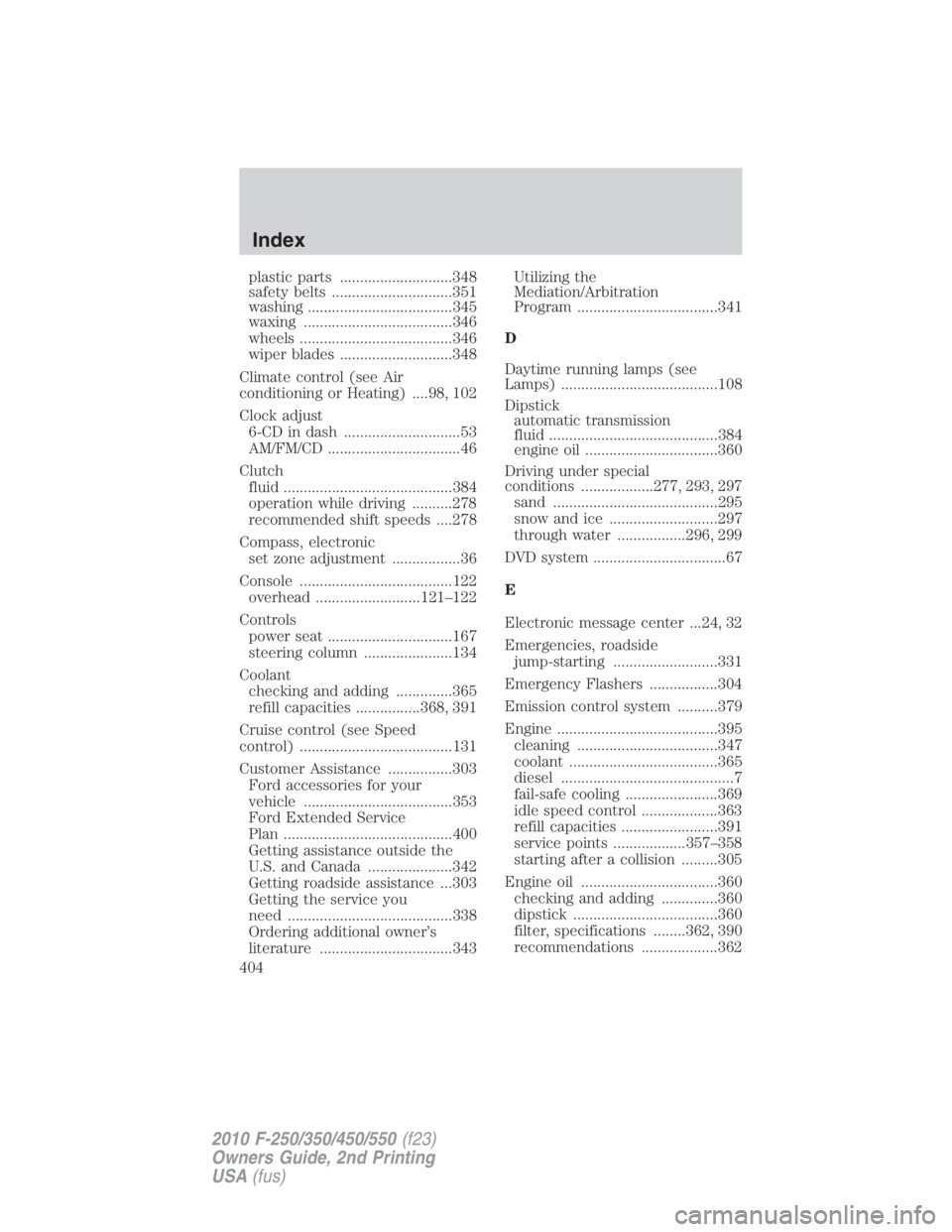
plastic parts ............................348
safety belts ..............................351
washing ....................................345
waxing .....................................346
wheels ......................................346
wiper blades ............................348
Climate control (see Air
conditioning or Heating) ....98, 102
Clock adjust
6-CD in dash .............................53
AM/FM/CD .................................46
Clutch
fluid ..........................................384
operation while driving ..........278
recommended shift speeds ....278
Compass, electronic
set zone adjustment .................36
Console ......................................122
overhead ..........................121–122
Controls
power seat ...............................167
steering column ......................134
Coolant
checking and adding ..............365
refill capacities ................368, 391
Cruise control (see Speed
control) ......................................131
Customer Assistance ................303
Ford accessories for your
vehicle .....................................353
Ford Extended Service
Plan ..........................................400
Getting assistance outside the
U.S. and Canada .....................342
Getting roadside assistance ...303
Getting the service you
need .........................................338
Ordering additional owner’s
literature .................................343 Utilizing the
Mediation/Arbitration
Program ...................................341
D
Daytime running lamps (see
Lamps) .......................................108
Dipstick
automatic transmission
fluid ..........................................384
engine oil .................................360
Driving under special
conditions ..................277, 293, 297
sand .........................................295
snow and ice ...........................297
through water .................296, 299
DVD system .................................67
E
Electronic message center ...24, 32
Emergencies, roadside
jump-starting ..........................331
Emergency Flashers .................304
Emission control system ..........379
Engine ........................................395
cleaning ...................................347
coolant .....................................365
diesel ...........................................7
fail-safe cooling .......................369
idle speed control ...................363
refill capacities ........................391
service points ..................357–358
starting after a collision .........305
Engine oil ..................................360
checking and adding ..............360
dipstick ....................................360
filter, specifications ........362, 390
recommendations ...................362Index
404
2010 F-250/350/450/550 (f23)
Owners Guide, 2nd Printing
USA (fus)
Page 405 of 408
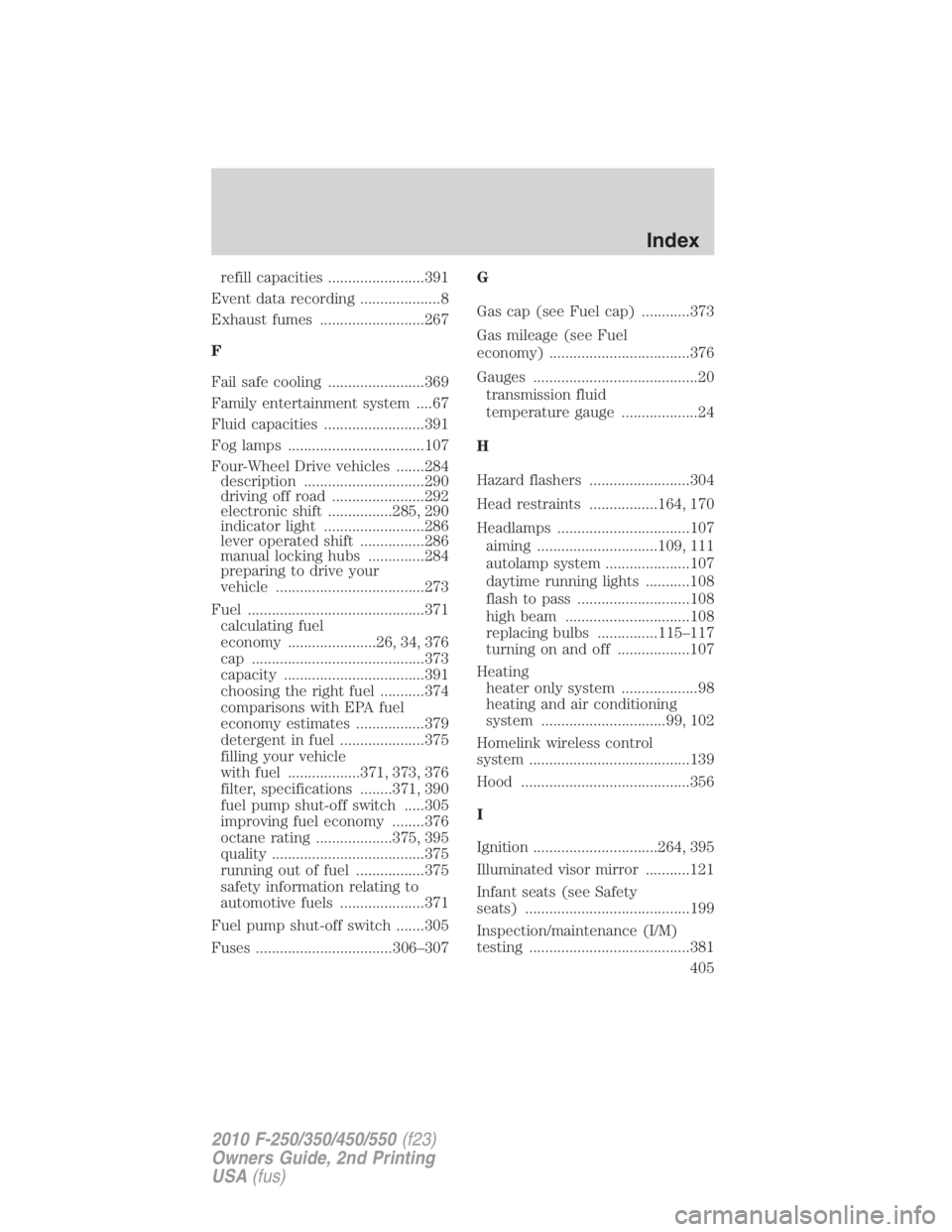
refill capacities ........................391
Event data recording ....................8
Exhaust fumes ..........................267
F
Fail safe cooling ........................369
Family entertainment system ....67
Fluid capacities .........................391
Fog lamps ..................................107
Four-Wheel Drive vehicles .......284
description ..............................290
driving off road .......................292
electronic shift ................285, 290
indicator light .........................286
lever operated shift ................286
manual locking hubs ..............284
preparing to drive your
vehicle .....................................273
Fuel ............................................371
calculating fuel
economy ......................26, 34, 376
cap ...........................................373
capacity ...................................391
choosing the right fuel ...........374
comparisons with EPA fuel
economy estimates .................379
detergent in fuel .....................375
filling your vehicle
with fuel ..................371, 373, 376
filter, specifications ........371, 390
fuel pump shut-off switch .....305
improving fuel economy ........376
octane rating ...................375, 395
quality ......................................375
running out of fuel .................375
safety information relating to
automotive fuels .....................371
Fuel pump shut-off switch .......305
Fuses ..................................306–307 G
Gas cap (see Fuel cap) ............373
Gas mileage (see Fuel
economy) ...................................376
Gauges .........................................20
transmission fluid
temperature gauge ...................24
H
Hazard flashers .........................304
Head restraints .................164, 170
Headlamps .................................107
aiming ..............................109, 111
autolamp system .....................107
daytime running lights ...........108
flash to pass ............................108
high beam ...............................108
replacing bulbs ...............115–117
turning on and off ..................107
Heating
heater only system ...................98
heating and air conditioning
system ...............................99, 102
Homelink wireless control
system ........................................139
Hood ..........................................356
I
Ignition ...............................264, 395
Illuminated visor mirror ...........121
Infant seats (see Safety
seats) .........................................199
Inspection/maintenance (I/M)
testing ........................................381 Index
405
2010 F-250/350/450/550 (f23)
Owners Guide, 2nd Printing
USA (fus)